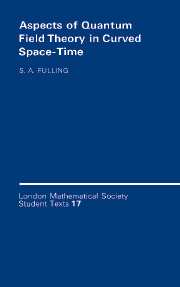Book contents
- Frontmatter
- Contents
- Preface
- 1 A quick course in quantum mechanics
- 2 Self-adjoint, elliptic differential operators and eigenfunction expansions
- 3 Quantization of a static, scalar field theory
- 4 Two-point functions
- 5 The stress tensor and the Casimir effect
- 6 Quantum field theory in general space-times
- 7 Quantum field theory in an expanding universe
- 8 Some geometrical apparatus
- 9 Renormalization of the stress tensor
- Conclusion
- Appendix: Varieties of Instability of a Boson Field in an External Potential and Black Hole Klein Paradoxes
- Bibliography
- Index
3 - Quantization of a static, scalar field theory
Published online by Cambridge University Press: 05 June 2012
- Frontmatter
- Contents
- Preface
- 1 A quick course in quantum mechanics
- 2 Self-adjoint, elliptic differential operators and eigenfunction expansions
- 3 Quantization of a static, scalar field theory
- 4 Two-point functions
- 5 The stress tensor and the Casimir effect
- 6 Quantum field theory in general space-times
- 7 Quantum field theory in an expanding universe
- 8 Some geometrical apparatus
- 9 Renormalization of the stress tensor
- Conclusion
- Appendix: Varieties of Instability of a Boson Field in an External Potential and Black Hole Klein Paradoxes
- Bibliography
- Index
Summary
When the quantum mechanics of particles appeared, circa 1925, its own inventors immediately realized that it was not really adequate for physics, for several reasons:
(1) It's nonrelativistic. This shortcoming can't be overcome simply by using (special) relativistic classical particle mechanics in place of nonrelativistic mechanics as the source of the equations of motion or the Hamiltonian. Attempts to do so led to relativistic wave equations, the Klein–Gordon and Dirac equations, which were afflicted with negative probabilities or negative energies, respectively. Superficially these could be eliminated by discarding half the solutions ad hoc, but the resulting theories developed inconsistencies when interactions were included.
(2) The states describe fixed numbers of particles. Therefore, the theory can't describe processes in which particles are produced or destroyed. Such interactions are observed experimentally, as when a proton and an antiproton annihilate into an electron, a positron, and a number of pions and photons.
(3) In electromagnetism (and also in gravitation) the principal object in the classical theory is a field, not a particle. It was therefore expected that the quantization process could be extended to fields.
In a sense, all these problems are the same problem. Special relativity implies the equivalence of mass and energy, hence the possibility that new particles can be produced when the particles coming into an interaction have total kinetic energy in excess of the total rest mass of the prospective products.
- Type
- Chapter
- Information
- Aspects of Quantum Field Theory in Curved Spacetime , pp. 48 - 73Publisher: Cambridge University PressPrint publication year: 1989



